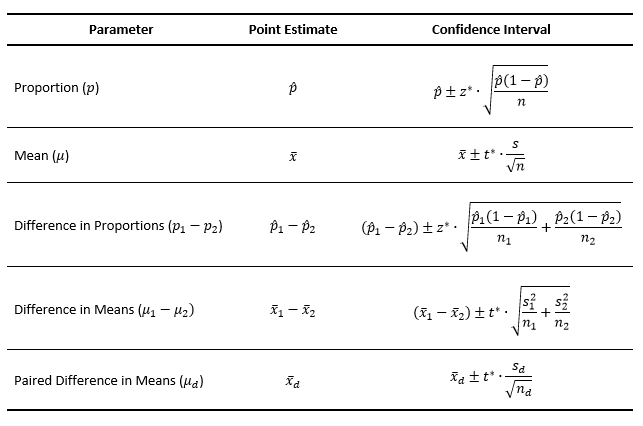Confidence Intervals
Confidence Intervals: The Basics
To estimate an unknown population parameter, start with a statistic that will provide a reasonable guess. The chosen statistic is a point estimator for the parameter. The specific value of the point estimator that we use gives a point estimate for the parameter.
A confidence interval gives an interval of plausible values for an unknown population parameter based on sample data. Plausible does not mean the same thing as possible. You could argue that just about any value of a parameter is possible. Plausible means that we shouldn't be surprised if any one of the values in the interval is equal to the parameter.
The interval estimate has the form point estimate ± margin of error.
When calculating a confidence interval, it is common to use the form statistic ± (critical value) ∙ (standard deviation of statistic).
To interpret a C% confidence interval, say "We are C% confident that the interval from ____ to ____ captures the [parameter in context]."
Reference:
Daren, S. S., & Tabor, J. (2020). Updated version of the practice of Statistics (Teachers Edition) (Sixth Edition). W H FREEMAN & CO LTD.
contributed by Katie Ciskowski
Creating Confidence Intervals
The use of confidence intervals is in part, due to the fact that the traditional and restricted framework of statistical significance testing has not been universally endorsed, therefore creating the need for confidence intervals.
This comes down to a simple question, "Is it possible to assert something positive and tangible about the means of the groups in an experimental study?"
Instead of using significance level in a study, it maybe more beneficial to use a confidence interval (which is the opposite of the significance level).
For example, saying "the 6 month survival rate wan increased by 30 percentage points with a 99% confidence interval" than by simple saying the difference between the control group and experimental group was significant at the .01 level.
The creation of the confidence interval then, becomes the percentage remaining from the significance level. In this this case 100-1= 99%
contributed by Mykal Kuslis, WCSU Cohort 8
Reference:
Meyers, S., Gamst, G., & Guarino, A.J. (2017). Applied multivariate research: Design and interpretation. Thousand Oaks, CA: Sage Publications. (p.24-25)
Confidence Interval: Formulas
contributed by David Ciskowski
